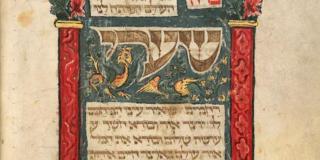
David bar Pesaḥ Maḥzor
David Bar Pesaḥ (Scribe)
David bar Pesaḥ Maḥzor
Manuscript on vellum
Germany, 14th century
The David bar Pesaḥ Maḥzor is a magnificent illuminated manuscript produced in Germany in the 14th century. Named after its scribe and decorator David Bar Pesah, who rose to prominence for his distinctive style of iconography, the manuscript is also known as the Padua Ashkenazi Maḥzor, having previously belonged to the Jewish community of Padua in Italy. The manufacturer and philanthropist Louis Rabinowitz, who initially bought the artifact for his private collection, donated the manuscript to the Library in the mid-20th century. The codex of 1,156 vellum pages bound in two volumes contains numerous examples of religious poems (piyutim) aimed to enhance festive synagogue services on holidays and special Shabbats, in addition to standard liturgical texts.
The stunning image of Shaare raḥamim (Gates of Mercy) shown here depicts a symbolic entry to Jerusalem in the Days of Atonement (Yom Kippur). We see an elegant architectural facade of the building that looks as if it were transported from the street of a medieval European city, with its graceful columns, pointed roof, and two pinnacles. The boldly sculpted red structure rests on the backs of two golden lions that guard this metaphoric getaway. The birds positioned on the roof of the building seem to sing in harmony, thus adding an additional sense of festivity to the scene. Inside the frame, the text of an important prayer for the morning service for Yom Kippur states: “Blessed are You, Adonai our God, who opens for us the gates of mercy and enlightens the eyes of those who yearn for His pardon.” The word shaare (gates) is enlarged and generously illuminated in gold.
This object can be displayed in an image on the exhibition website. Use the Official Image field to upload an image. Use the Copyright Status as the Official Image Rights Statement. If present in your search result, Use the Copyright Notice as the Official Image Copyright Notice.






